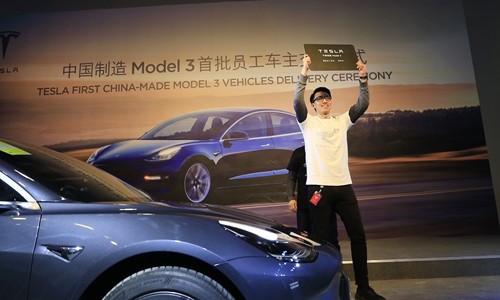Tesla delivers first batch of made-in-China Model 3s to 15 employees
Domestic content to rise swiftly in 2020

Tesla delivers a grey-colored made-in-China Model 3 to one Tesla salesperson in Shanghai, one of the 15 Tesla employees who becomes the first batch of made-in-China Model 3 owners. Photo: Yang Hui/GT
US-based electric carmaker Tesla delivered its first batch of made-in-China Model 3s to 15 of its Chinese employees - from salespeople to delivery team workers - on Monday.
The employees, who work in different cities including Shanghai, Beijing and Hangzhou, gathered at the Gigafactory 3 in Shanghai to receive the cars. The first made-in-China Model 3, grey-colored, was delivered to a Tesla salesperson in Shanghai.
When the 15 cars were driven slowly to the delivery point, they were surrounded by crowds of Tesla employees who gave a loud cheer. One Model 3 owner even used the car as a gift to propose to his girlfriend.
The US electric carmaker, which invested in China amid bumpy China-US trade relations, has pushed forward its investment in a steadfast way, including constructing the Shanghai plant in less than 10 months and assembling a large, localized talent team in a very short period.
But it is now facing a more critical year ahead in 2020, when its localization efforts in China will be tested, finally, by the market.
The company will start delivering made-in-China Model 3s to customers in the Chinese mainland presumably in early January, Tesla executives said on Monday.
"Demand for the made-in-China Tesla Model 3s has been very hot," Wang Hao, general manager of Tesla China, told the Global Times on Monday, without disclosing the actual order numbers.
"We have a goal of selling every Model 3 that we produce in the Shanghai plant, and we are very confident of achieving that goal," Wang said.
Song Gang, production director of the Tesla Gigafactory 3, said that the factory produces 28 or more Model 3s every hour and works about 10 hours each day, which means that it produces more than 1,000 cars each week.
He added that the factory will be able to produce 3,000 cars per week "in the near future."
Tao Lin, vice president of Tesla, announced that the Shanghai plant's production capacity will be further enhanced in 2020. "Compared with traditional car manufacturers, Gigafactory 3's production capacity will ramp up at a speed that exceeds your imagination," she said.
The Tesla executives also disclosed that about 30 percent of the made-in-China Model 3 parts are sourced in China. The Model 3's localization level will climb to about 80 percent by around mid-2020 and the car will be totally localized by the end of next year, meaning that all of its parts will be supplied by Chinese companies.
Tesla has been investing in China, the world's largest auto market, to find opportunities in the country's rapid new-energy vehicle (NEV) development. According to a report compiled by the China Automotive Technology and Research Center Co entrusted by the Ministry of Commerce, NEVs will gradually become a major area for future automobile market growth, and China's NEV exports are expected to maintain rapid growth in the next few years.
Zeng Zhiling, a car expert at Shanghai-based consultancy LMC Automotive, said that Tesla has achieved good timing in China.
"It is earlier than some other car brands like Volkswagen, in terms of NEV mass production layout - but not too early when Chinese consumers didn't have enough knowledge about electric cars," he told the Global Times on Monday.
Zeng is also optimistic that Tesla is likely to see its Model 3 sales double in 2020 in China, thanks to the brand's technological advantage and further room for price cuts. Tesla sold about 30,000 Model 3s this year.
According to him, the entrance of more high-end NEVs including Tesla and other traditional well-known car brands into China will "bring a completely different picture" to the country's NEV market, which has been slowing down in 2019 due to receding government support and the dominance of cheap, technologically unqualified NEV carmakers.
Sales of NEVs in China stood at about 1.04 million in the first 11 months this year, up by 1.3 percent on a yearly basis, compared with 68 percent growth in the same period in 2018.
Newspaper headline: Tesla delivers first local Model 3s